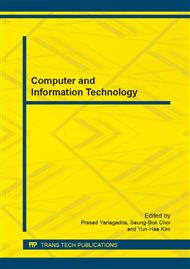[1]
M. Conti, S. Giordano, M. May, and A. Passarella, From opportunistic networks to pportunistic computing, Communications Magazine, vol. 48, no. 9, p.126–139, (2010).
DOI: 10.1109/mcom.2010.5560597
Google Scholar
[2]
C. M. A. M. Khabbaz and W. Fawaz, Disruption-tolerant networking: A comprehensive survey on recent developments and persisting challenges, IEEE Commun. Surveys & Tutorials, vol. 14, no. 2, p.607–640, (2012).
DOI: 10.1109/surv.2011.041911.00093
Google Scholar
[3]
A. Vahdat and D. Becker, Epidemic routing for partially connected ad hoc networks, Technical Report CS-200006, (2000).
Google Scholar
[4]
A. Lindgren, A. Doria, and O. Schel´en, Probabilistic routing in intermittently connected networks, SIGMOBILE Mob. Comput. Commun.
DOI: 10.1145/961268.961272
Google Scholar
[5]
Rev., vol. 7, no. 3, p.19–20, jul 2003. H. Pan, J. Crowcroft, and E. Yoneki, Bubble rap: Social-based forwarding in delay-tolerant networks, Mobile Computing, vol. 10, no. 11, p.1576–1589, (2011).
DOI: 10.1109/tmc.2010.246
Google Scholar
[6]
F. Li and J. Wu, Mops: Providing content-based service in disruptiontolerant networks, Distributed Computing Systems, 2009. 29th IEEE International Conference on, p.526–533, June (2009).
DOI: 10.1109/icdcs.2009.28
Google Scholar
[7]
L. Feng and W. Jie, Localcom: A community-based epidemic forwarding scheme in disruption-tolerant networks, 6th Annual IEEE Communications Society Conference on, p.1–9, (2009).
DOI: 10.1109/sahcn.2009.5168942
Google Scholar
[8]
E. Bulut and K. Szymanski, B, Friendship based routing in delay tolerant mobile social networks, Global Telecommunications Conference, 2010 IEEE, p.1–5, (2010).
DOI: 10.1109/glocom.2010.5683082
Google Scholar
[9]
L. Gao, M. Li, A. Bonti, W. Zhou, and S. Yu, Multidimensional routing protocol in human-associated delay-tolerant networks, IEEE Transactions on. Mobile Computing, vol. 12, no. 11, p.2132–2144, (2013).
DOI: 10.1109/tmc.2012.188
Google Scholar
[10]
A. -K. Pietil¨ainen, E. Oliver, J. LeBrun, G. Varghese, and C. Diot, Mobiclique: middleware for mobile social networking, Proceedings of the 2nd ACM workshop on Online social networks, p.49–54, (2009).
DOI: 10.1145/1592665.1592678
Google Scholar
[11]
A. Ker¨anen, T. K¨arkk¨ainen, and J. Ott, Simulating mobility and dtns with the one, Journal of Communications, vol. 5, no. 2, p.92–105, (2010).
Google Scholar


